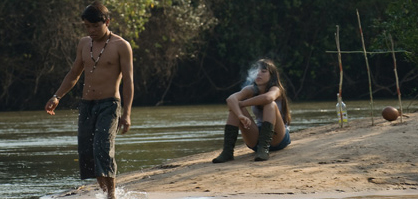Primary navigation

Italy/Brazil 2008

Reviewed by Sophie Mayer
Our synopses give away the plot in full, including surprise twists.
Mato Grosso do Sul, Brazil, the present. When a young Guarani-Kaiowá woman commits suicide, Nádio leads his community to form a protest camp on the borders of a local farm that sits on their ancestral burial ground.
The lives of the Guarani and European-descended communities are inextricably linked: Nádio manages the pressure of his job with booze bought on credit (and against the law) from Dimas, the local shopkeeper; Nádio’s son Irineu joins other Guarani men earning a pittance food processing; trainee shaman Osvaldo falls for Maria, the farmer’s teenage daughter. When Ireneu commits suicide, the fissures between the two worlds are made manifest. Nádio plans a confrontation to regain the sacred territory, and succeeds in securing the title to the land from a lawyer. The farmer and other landowners kill Nádio after he is betrayed by Tito, a Guarani man expelled from the community for attempted rape. Osvaldo avenges the deaths of Nádio and Irineu by confronting the evil spirit Anguè, as embodied by the farmer and his family.
It takes a director who has worked with Jorge Luis Borges to appreciate and depict the absurdities of life for indigenous people in the Amazon basin. Marco Bechis’ unsentimental and fiercely intelligent feature BirdWatchers reflects not only his own political expulsion from Argentina in the 1970s but also Chip, the film he planned with the great Argentine writer. BirdWatchers, set in Mato Grosso do Sul in Brazil, may not recall the radical mode of Third Cinema, but its tonal complexity, compelling performances and precise evocations of the spirit world are a far cry from the liberal campaigning film a viewer might expect on hearing that it is produced by Survival International.
There’s no mistaking the political commitment here, however: this film is on the side of what the blunter Italian title calls La terra degli uomini rossi – “the land of the red men”. Blunter, but also more alive with the reversals that structure the film’s narrative: the “red men” could equally refer to the European landowners caught red-handed colluding to abuse, sedate and even murder the Guarani-Kaiowá people on whose land they farm cattle and genetically modified sugar beet. The bitter Borgesian ironies come to a head in a climactic confrontation between Nádio, who has led an occupation of the Guarani ancestral lands on the advice of his shaman, and the landowner Moreira, who protests that the territory has been in his family for three generations.
Moreira figures not only for individual landowners but for the European colonial nation-states of the Americas, squatters on land that they have appropriated and ruined. Nádio and his community aren’t inviting our Last of the Mohicans pity, however. The film’s opening track along the bank of the Amazon ‘discovers’ a group of Guarani in loin cloths and face-paint looking mournfully out of the forest; it suggests noble-savage clichés but these are swiftly revoked when the group, having provided a spectacle for the tourists, turn away to collect their pay before riding off in a truck. Startling and effective, the Guarani characters refuse to be extinct, despite contemporary Eurocentric Brazil relegating them to marginal roles as servants, day labourers and historical relics. And worse: the film makes the case for an ongoing genocide, wrought by alcohol, guns and farming. The story is framed by the suicides of two young Guarani: the first incites Nádio’s protest camp, and the second – of his son Irineu – sparks the film’s climactic confrontation. The suicides also precipitate death rituals which, far from anthropological curiosities, are part of the film’s original visual and narrative language – its way of speaking Guarani.
The patience of the camera captures the boredom of life on the margins, but in addition the film has a remarkable cinematic ability to move the viewer into the Guarani worldview, particularly via repeated camera movements and soundwashes that announce the intrusion of the spirit Anguè, the death-dealer brought by the suicides and their causes. When Osvaldo, a young shaman-in-training and Irineu’s best friend, confronts the farmer’s family, he becomes and expels Anguè; the film’s closing shot spirals above the trees, identifying the intrusive evil presence with the camera and hence the viewer.
Anguè is associated with a bird’s-eye view, and hence with the birdwatching – detached from the natural world, superior to it – of the tourists brought in by the farmer’s wife. So the film’s English title has a Borgesian irony all of its own: watching, the key sense of cinema, is compromised by distance and its sense of uninvolved superiority. Through Osvaldo, the film presents us with an alternative, that of watching by listening, not least to the layered diegetic soundtrack and eerie sound editing. In a final, brilliant irony, the credits reveal that the soundtrack’s baroque choral music is deeply embedded in the landscape over which it sings, composed by Jesuit missionary Domenico Zipoli, who trained Guarani musicians in Paraguay in the early 1700s. Cogent, thrilling and resonant, it’s a final layer in a film that makes a vivid attempt to equal in complexity the lives and culture it captures.